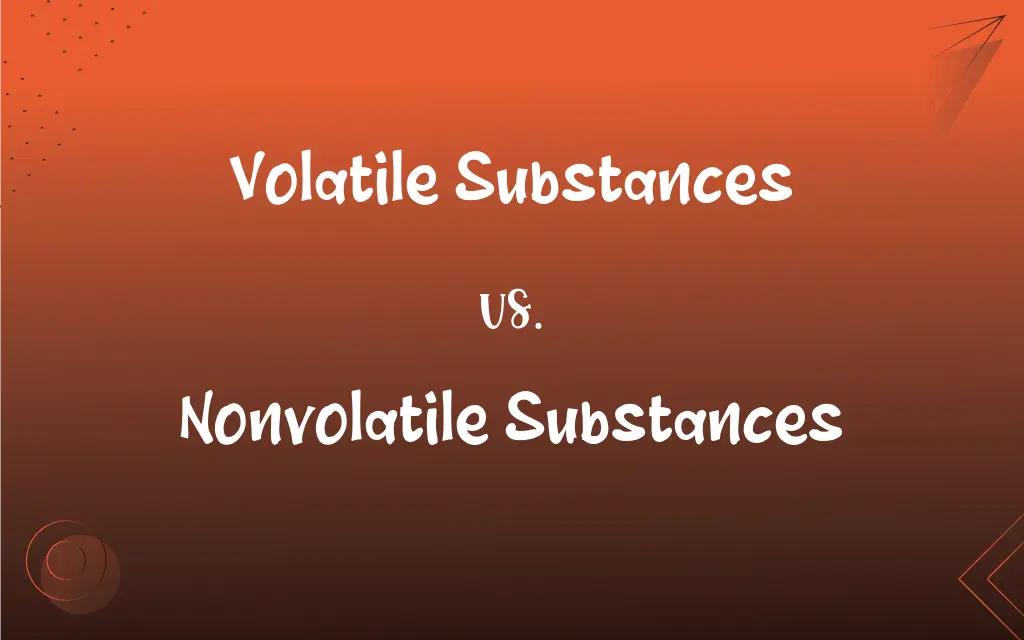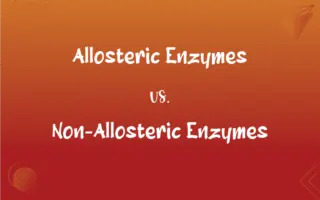Volatile Substances vs. Nonvolatile Substances: What's the Difference?
By Janet White || Published on March 4, 2024
Volatile substances easily vaporize at low temperatures, while nonvolatile substances do not readily evaporate and remain stable.

Key Differences
Volatile substances are characterized by their high vapor pressure and low boiling points, which allow them to vaporize or evaporate at room temperature or below. This property is due to weak intermolecular forces within the substance, making them readily convert from a liquid or solid state to a gas. On the other hand, nonvolatile substances exhibit low vapor pressure and high boiling points, making them resistant to evaporation. The strong intermolecular forces within nonvolatile substances keep their molecules closely bound together, preventing them from easily transitioning to a gaseous state.
Volatile substances find widespread use in perfumes and air fresheners because their ability to quickly vaporize disperses their scent into the air efficiently. In contrast, nonvolatile substances are commonly found in lubricants and sealants where their stability and resistance to evaporation under normal conditions are valued. This distinction highlights how the volatility of a substance directly impacts its practical applications and suitability for specific purposes.
The environmental impact of volatile substances is significant, as their propensity for vaporization contributes to air pollution and the formation of ground-level ozone. Nonvolatile substances, however, tend to have a lesser immediate impact on air quality due to their stability and low vapor pressures. This makes nonvolatile substances preferable in scenarios where minimal environmental volatility is desired.
In chemical analysis, the volatility of a substance can affect the techniques used for separation and identification. Techniques such as gas chromatography rely on the volatile nature of compounds to separate them based on their vaporization properties. Conversely, for nonvolatile substances, methods like liquid chromatography or mass spectrometry are more applicable, underscoring the role of volatility in determining the appropriate analytical approach.
Safety measures in handling volatile substances are crucial due to their flammability and potential health hazards upon inhalation. Nonvolatile substances, while generally posing less risk of inhalation or explosion, may still require careful handling due to other chemical properties. This distinction underlines the importance of understanding the volatility of substances to ensure appropriate safety protocols are followed.
ADVERTISEMENT
Comparison Chart
Vapor Pressure
High, facilitating evaporation at low temperatures
Low, resisting evaporation under similar conditions
Boiling Point
Low, indicating ease of transition to the gas phase
High, reflecting stability in liquid or solid form
Intermolecular Forces
Weak, allowing molecules to separate easily
Strong, keeping molecules closely bound
Common Uses
Perfumes, air fresheners due to quick scent dispersion
Lubricants, sealants due to stability and durability
Environmental Impact
Contributes to air pollution, ground-level ozone
Lesser immediate impact on air quality
ADVERTISEMENT
Volatile Substances and Nonvolatile Substances Definitions
Volatile Substances
Chemicals that disperse easily into the air due to their molecular structure.
The fragrance from a spray is due to volatile substances that spread the scent.
Nonvolatile Substances
Substances that do not easily evaporate at room temperature.
Salt is a nonvolatile substance, remaining solid without evaporating.
Volatile Substances
Elements or compounds that exhibit rapid phase changes under standard conditions.
Dry ice sublimates directly from solid to gas, showcasing its volatile nature.
Nonvolatile Substances
Compounds with low vapor pressures, resisting vaporization.
Vegetable oil is a nonvolatile substance, staying liquid without forming vapors.
Volatile Substances
Compounds with high vapor pressures at normal temperatures.
Gasoline, a volatile substance, can vaporize rapidly, posing a fire risk.
Nonvolatile Substances
Elements or compounds that exhibit minimal phase changes under normal environmental conditions.
Plastic is a nonvolatile substance, retaining its form without evaporating.
Volatile Substances
Materials that convert from liquid to gas at low temperatures.
Mercury is a volatile substance, even vaporizing at room temperature.
Nonvolatile Substances
Materials that maintain their state under standard conditions due to strong intermolecular forces.
Glass is a nonvolatile substance, maintaining its solid form indefinitely.
Volatile Substances
Substances that evaporate quickly at room temperature.
The alcohol in hand sanitizer is a volatile substance, evaporating quickly once applied.
Nonvolatile Substances
Chemicals that remain stable and do not readily change to a gas phase.
Silicone sealant is a nonvolatile substance, used for its stability and durability.
FAQs
Why are volatile substances used in perfumes?
Their ability to rapidly evaporate helps disperse scent molecules into the air efficiently.
What defines a volatile substance?
A substance that easily vaporizes at low temperatures due to its high vapor pressure and weak intermolecular forces.
How are nonvolatile substances handled safely?
While less flammable, precautions include avoiding direct contact and following specific storage guidelines.
Which analytical techniques are suitable for volatile substances?
Gas chromatography is commonly used due to the substances' ability to vaporize.
What are nonvolatile substances?
Substances with low vapor pressures that do not readily evaporate, maintaining stability due to strong intermolecular bonds.
What safety precautions are necessary for volatile substances?
Proper ventilation, fire prevention measures, and protective equipment to avoid inhalation or fire hazards.
Can nonvolatile substances be used as perfumes?
Typically not, as their resistance to evaporation prevents the efficient dispersion of scent.
How do volatile substances impact the environment?
They contribute to air pollution and ground-level ozone formation due to their ease of vaporization.
Are nonvolatile substances environmentally friendly?
They have a lesser immediate impact on air quality, but their environmental friendliness depends on other chemical properties.
Why do volatile substances have low boiling points?
Their weak intermolecular forces require less energy to transition to the gas phase, resulting in low boiling points.
Can nonvolatile substances be made volatile?
Potentially, through chemical alteration, but this often requires significant changes to their structure.
Can volatile substances be made less volatile?
Yes, by chemical modification or by controlling the temperature and pressure conditions.
How does temperature affect the volatility of a substance?
Higher temperatures increase volatility by providing energy to overcome intermolecular forces.
Are all volatile substances flammable?
Many are due to their ease of vaporization and mixture with air, but not all volatile substances are flammable.
Do nonvolatile substances pose health risks?
While generally less hazardous in terms of inhalation, they can pose risks depending on their chemical nature.
Can volatile substances be contained?
Yes, using airtight containers and controlling environmental conditions can minimize evaporation.
What techniques are used for analyzing nonvolatile substances?
Liquid chromatography or mass spectrometry, suitable for compounds that do not easily vaporize.
What role do intermolecular forces play in volatility?
Weak intermolecular forces lead to high volatility, while strong forces result in low volatility.
Why are nonvolatile substances preferred in lubricants?
Their resistance to evaporation ensures long-lasting performance and stability.
Are there any beneficial uses of nonvolatile substances in daily life?
Yes, including in food preservation, as sealants, and in manufacturing processes where stability is key.
About Author
Written by
Janet WhiteJanet White has been an esteemed writer and blogger for Difference Wiki. Holding a Master's degree in Science and Medical Journalism from the prestigious Boston University, she has consistently demonstrated her expertise and passion for her field. When she's not immersed in her work, Janet relishes her time exercising, delving into a good book, and cherishing moments with friends and family.






































































